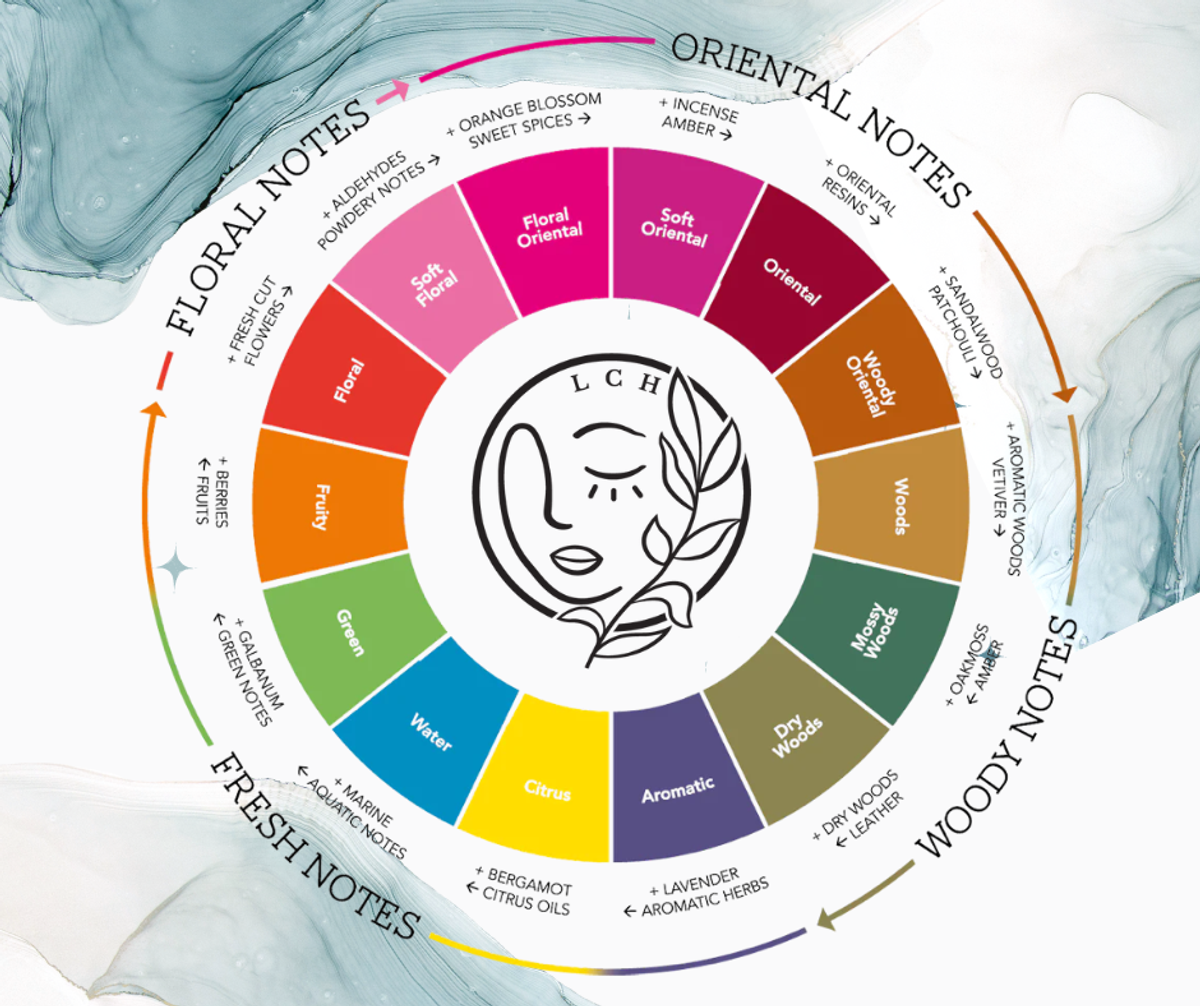
If you are interested in blending and making perfume either as hobby or as a profession.
This post will be great in building your foundation of understanding the real meaning of "The Art of Perfumery".
The language of perfumery comprises base notes, middle (or heart) notes, and top (or head) notes, with fixatives and other bridging elements. This system is known as "The gamut of odors". In the whole gamut of odors, the perfume or blend scent of Essential Oil has to be the symphony and harmony of the whole bottle of the 'end result'.
By knowing the theory of perfumery, you will be able to know what is harmony and what is the discord of smells in blending perfumery.
Natural Perfumes are dynamic and change with people and with time. As perfume can or may react differently on skin type and body heat. So it is important to test and give time for your perfume or blended essential oil to cure through time (or at least 4 weeks).
Understanding Perfumery Notes (The Art of Blending scent)
The particles in scent are its volatility. If it is fast in evaporating, then it is called a TOP NOTE, next will be the MIDDLE NOTE, and then the BASE NOTE.
As this is written, it seems that it is like a straightforward theory, however in reality. This is not the case, as sometimes we can find scent categories that should be in the TOP NOTE can end up being the MIDDLE NOTE, as chemical reactions have a hard theory to explain when it is curing.
What is an 'ACCORD'?
Accord is the perfumer's word for a perfume formulation for a particular note. People who are mastery in perfumes may have Chypre Accord, Green Accord, Oriental Accord, Floral Accord, Citrus Accord, Green Accord, Rose Accord, Resinous and Wood-type Accord, Amber Accord and etc.
These are some Essential Oils that could be included in an 'Accord'?
- Green Notes: Basil, Peppermint, Chamomile, Clary Sage.
- Floral Notes: Ylang Ylang, Rose, Geranium, Lavender.
- Wood Notes: Cedarwood, Cypress, Sandalwood, Rosewood.
- Spice Notes: Ginger, Black pepper, Nutmeg, Cardamom, Coriander.
- Citrus Notes: Bergamot, Orange, Yuzu, Mandarin, Lime.
- Amber Type: Patchouli, Benzoin, Vetiver, Vanilla, Balsam Tolu.
FEMININE NOTES vs MASCULINE NOTES
In traditional notes, there are notes that differentiate into feminine and masculine notes. These are notes that carry gender to help you better identify and recognize in building your perfume characteristics and specialty.
Feminine Notes are found in female fragrances:
| TOP (HEAD) NOTES | MIDDLE (HEART) NOTES | BASE NOTES |
|
|
|
Examples of Feminine notes combination would be:
| Base Notes: Vetiver + Vanilla + Sandalwood + Balsam De Peru + Benzoin + Balsam Tolu (This combination would be called "Sweet Balsamic" Note.) |
| Middle Notes: Jasmine + Rose + Carnation + Ylang Ylang + Tuberose (This combination would be called "Sweet, Floral + Spice Note.) |
| Top Notes: Lemon + Mandarin + Bergamot + Rosewood. (This combination would be called "Citrus Fresh" Note.) |
Masculine Notes that are found in Male Fragrances:
These notes are found in these traditional scents, and could also be lesser in concentration.
| TOP (HEAD) NOTES | MIDDLE (HEART) NOTES | BASE NOTES |
|
|
|
Examples of Masculine notes combination would be:
| Base Notes | Tonka Bean + Cedarwood (This combination is called a "LIGHT" wood base note.) |
| Middle Notes | Lavender + Carnation + Juniper Berry + Jasmine + Line (This combination is called a "Green and Resinous" note.) |
| Top Notes | Lavender + Anise + Lemon + Lime + Petitgrain + Mandarin + Bergamot (This is a combination is called a "Citrus fresh and Herbaceous" note.) |
However, after the combination of fragrances. The fragrances of the blend could change in nature, and this is where fixation and other bridging ingredients come in to stabilize the quality of the fragrances in nature.
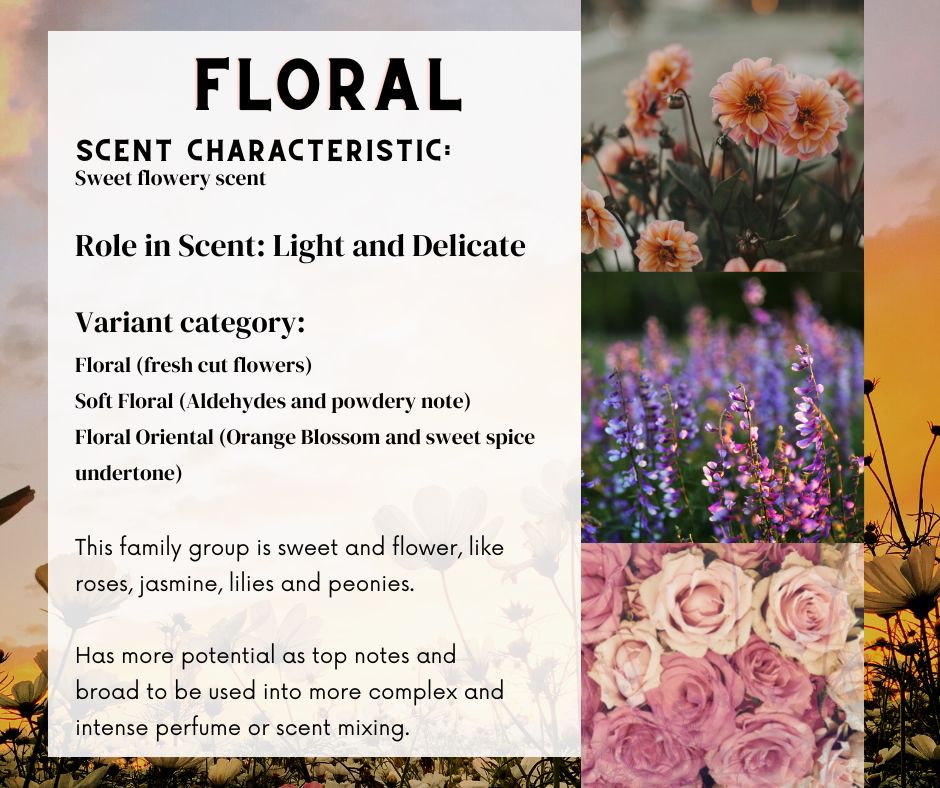
Floral Notes
Floral fragrances are popular in the wheel of fragrances. Floral scent are often used in women’s fragrances and usually carries a fresh-cut floral or have a powdery note to them.
Most of the time, they represent spring or summertime.
Character of Scent:
Sweet and flower, and can range from light and delicate (such as Neroli and Jasmine), to more complex and intense scent (rose, lilies and peonies).
Sub-families:
Fruity: Sweet, Edible and Tropical like Peach, Pear and Apple
Floral: Smells like fresh cut flowers
Soft Floral: Soft, powdery and sweet with hint of creaminess.
Floral Oriental: Floral with subtle spice notes.
Common Floral Family Notes:
- Rose
- Jasmine
- Orange Blossom
- Apple Blossom
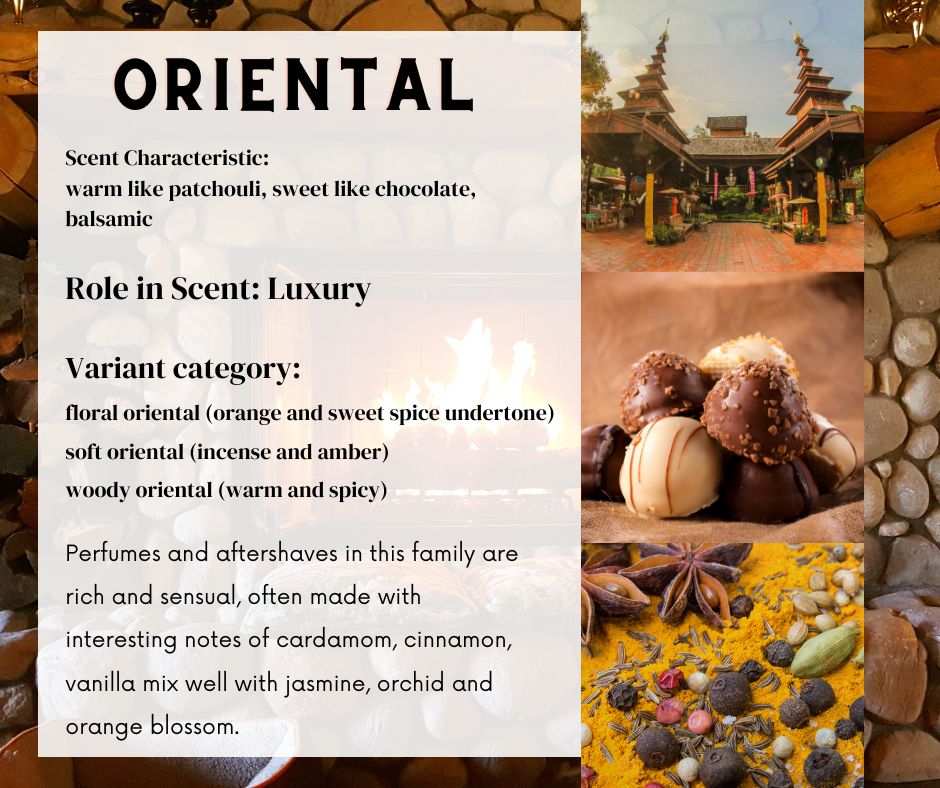
Oriental Notes
The oriented notes consists of rich exotic scents. Herbs and spice or dry, powdery, resin notes. Opulent and heady, these notes are often times softened with amber or sweet notes.
Often described as exotic and seductive.
Character of scent note:
Spicy and dry (Black pepper, Anise, Myrhh), powder and resin (Moonlight, Benzoin, Cinnamon), herbal note (Rosemary, Sweet Marjoram)
Subfamilies:
Soft oriental: Soft, floral notes mix with incense and warm spices.
Oriental: Sweet, warm notes like Cinnamon, Vanilla and Musk.
Woody Oriental: Earthy notes like Patchouli and Sandalwood mixed with spicy and sweet notes.
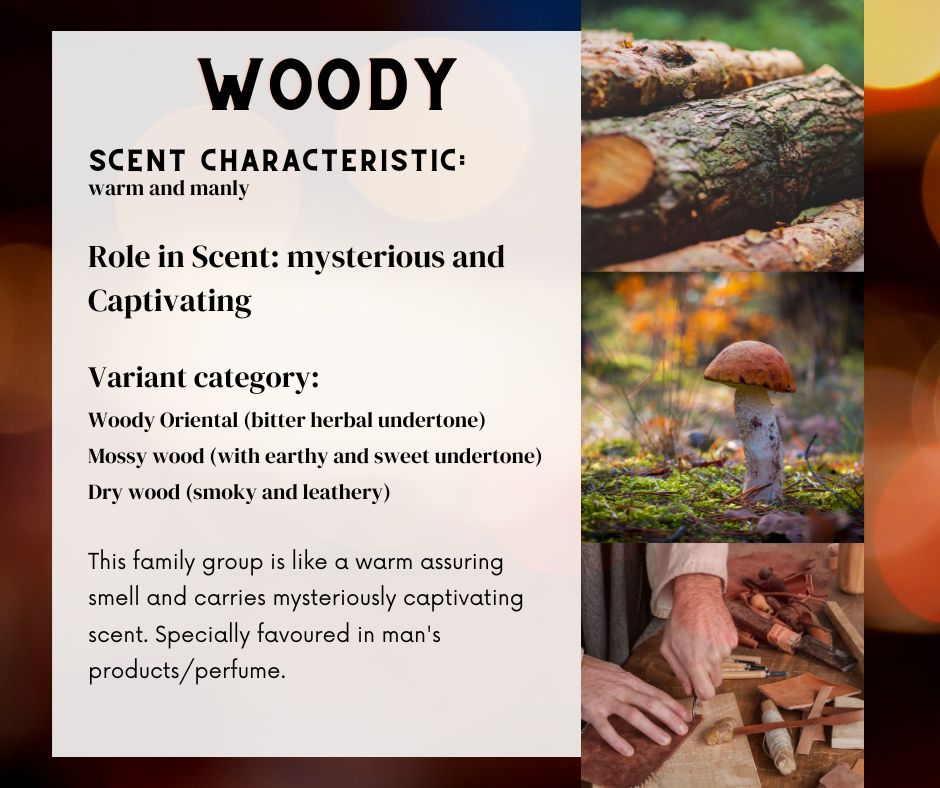
Woods
Woody notes are usually warm luxurious and opulent. Consist of incense-like fragrances like Sandalwood and Patchouli with drier notes like cedarwood.
Sometimes, Citrus and floral would be a great option to tone down the warmth scent of this woody family.
Character of scent note:
Coniferous, woody, and bitter.
Subfamilies:
Woods: Cedarwood, Sandalwood, and Vetiver
Mossy Woods: sweet and earthy, smooth and silky, amber or oakmoss
Dry Woods: Smoldering and smoky mixed like tobacco or leather.
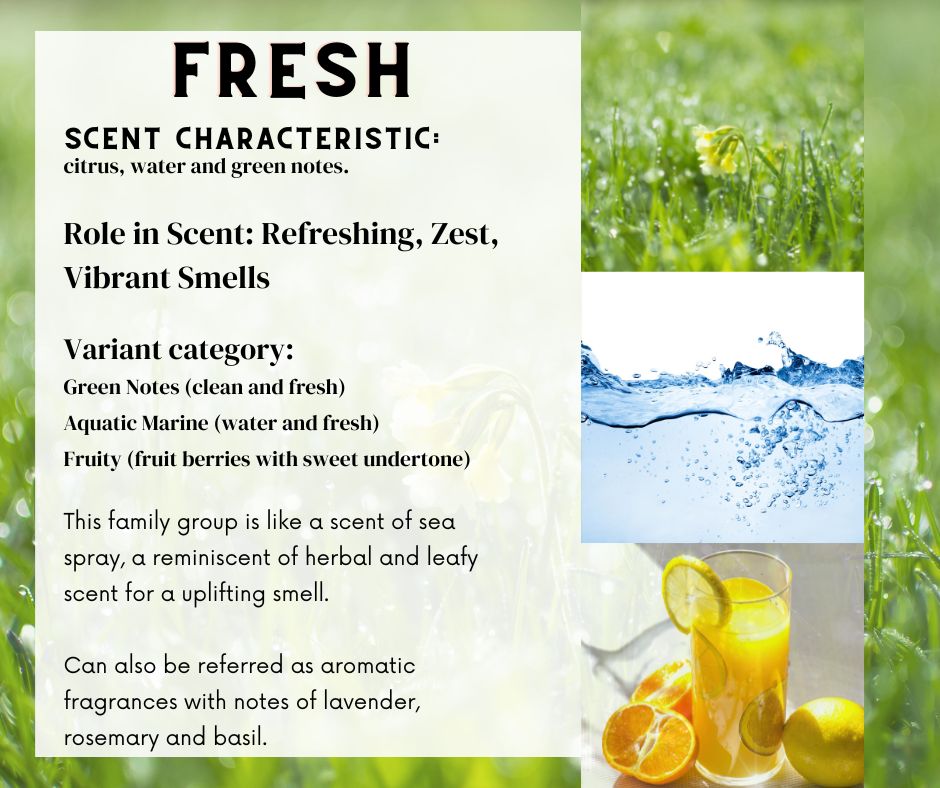
Fresh Notes
Encompasses a clean and bright scent. Herby and oceanic scents, can sometimes found in citrusy category as well. Fresh scent can sometimes paired with spicy note that could create a strong and bold fragrance.
Character of scent note:
Fresh, clean, refreshing, inspiring, awakening.
Subfamilies:
Aromatic: Lavender, Rosemary, Sweet Marjoram
Citrus: All citrus fruit
Water: Oceanic, aquatic and sea notes
Green: Fresh green leaves or grass.
